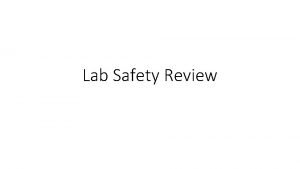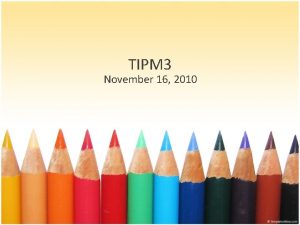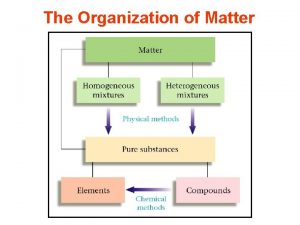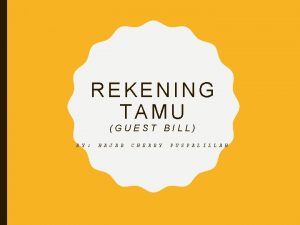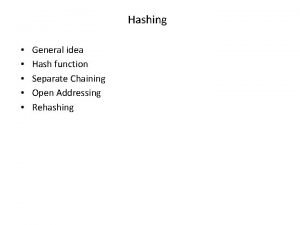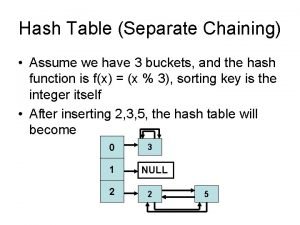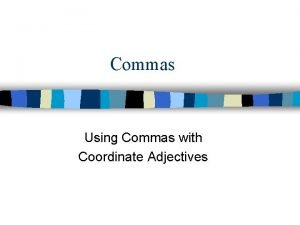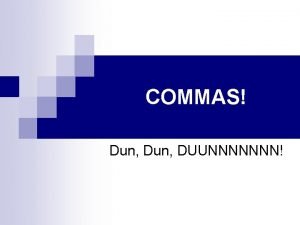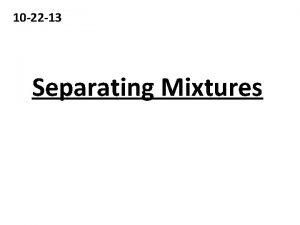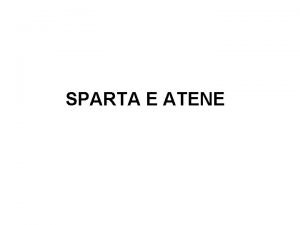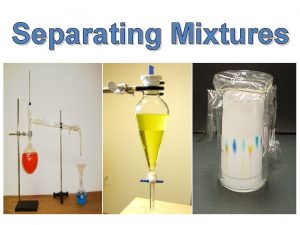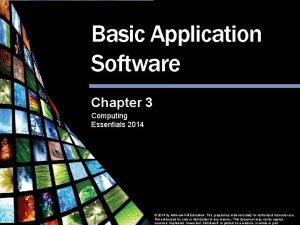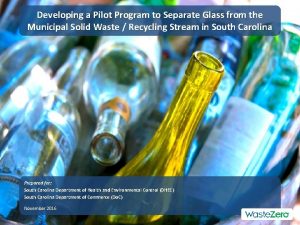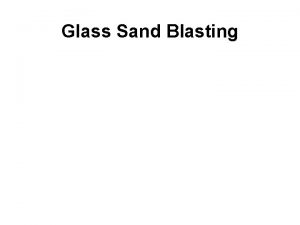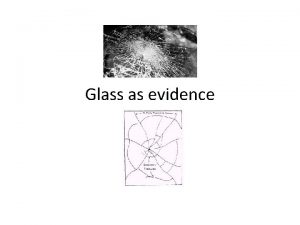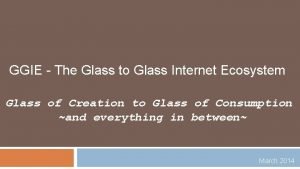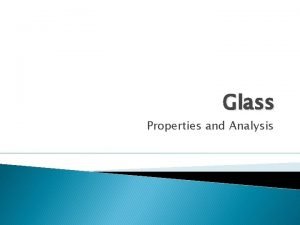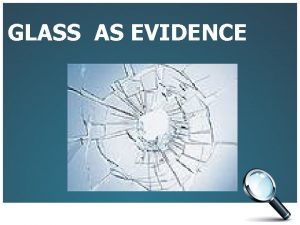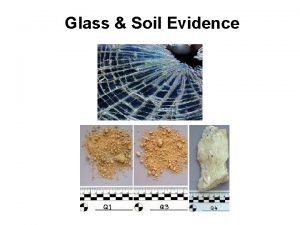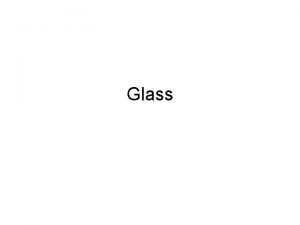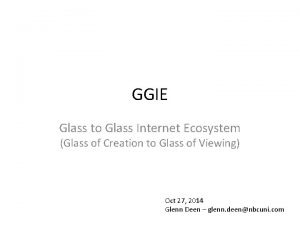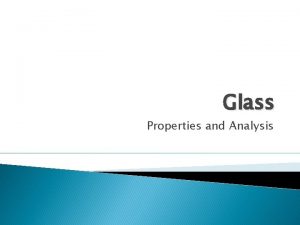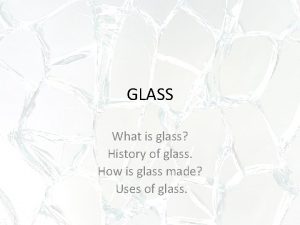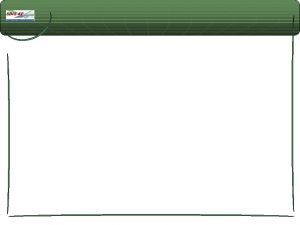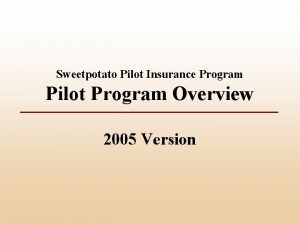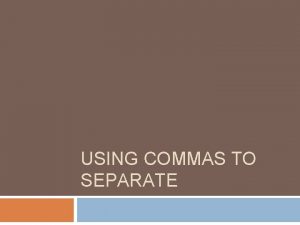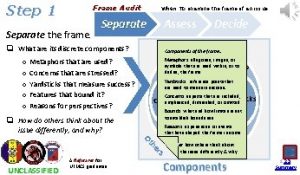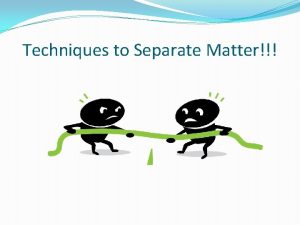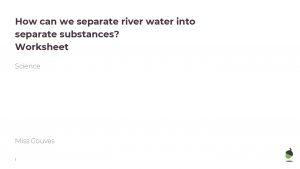Developing a Pilot Program to Separate Glass from


































- Slides: 34

Developing a Pilot Program to Separate Glass from the Municipal Solid Waste / Recycling Stream in South Carolina Prepared for: South Carolina Department of Health and Environmental Control (DHEC) South Carolina Department of Commerce (Do. C) November 2016 Prepared by Waste. Zero, Inc. , 2016

Contents Item Page Background 3 Project Objectives 4 Glass Recycling in SC: Scope and Impact 5 The Problem and Potential Solution 16 The Pilot and How It Would Work 23 Conclusion 33 Next Steps 34 Prepared by Waste. Zero, Inc. , 2016 2 2

Background • Glass breaks during the collection and processing of single-stream recycling, destroying the value of the glass and contaminating all other commodity streams. • Some in SC have advocated discontinuing glass recycling, treating it as trash instead. Discontinuing glass recycling would most likely − Decrease the volume of recyclables collected and significantly reduce the recycling rate (due to weight) − Increase disposal costs − Send a mixed message to residents, potentially discouraging some from recycling at all − Be politically unpopular, and might increase the interest in a bottle bill from environmental groups • Ideally, glass should be separated from the trash and the rest of the recycling stream to be recycled separately. This would − Prevent municipalities from having to pay to landfill glass − Prevent glass from destroying the value of other recyclables − Enable more glass—and its value—to be recovered • SC DHEC and the SC Department of Commerce are interested in understanding the magnitude of the glass problem in SC, as well as potential means of piloting a solution. Prepared by Waste. Zero, Inc. , 2016 3 3

Project Objectives SC DHEC and the SC Department of Commerce approved a small initial project—for which this document is the primary deliverable—to achieve the objectives outlined below. 1 Understand the magnitude of the glass problem in SC 2 Outline a potential solution (that could be piloted) for efficiently segregating glass from the trash and single-stream recycling, and processing it separately. Provide initial guidance as to how the results of the pilot could be evaluated 3 Ultimately, a pilot program will help determine if the proposed solution’s benefits outweigh its costs: Potential Benefits • • Increased glass diversion Disposal savings Increased value of single-stream commodities Increased value of diverted glass Prepared by Waste. Zero, Inc. , 2016 Potential Costs • Cost to manage program • Cost to separate glass 4 4

Glass Recycling in SC Scope and Impact Prepared by Waste. Zero, Inc. , 2016 5 5

Development of Recycling in South Carolina Over the past two decades, residential recycling in South Carolina has evolved from primarily drop-off convenience sites to 76 municipal curbside programs serving more than 1. 1 million residents in 402, 000 households. This evolution has pushed recycling rates up to nearly 30%. Drop-Off Sites Dual Stream Recycling Single-Stream Recycling rates were typically low Recycling rates increased Recycling increased MRFs generally did not charge tip fees MRFs continued with no tip fees (for a while) “Free” approach helped gain acceptance from local officials who had to invest in personnel & equipment Contamination increased Cost of drop-off centers was included in taxes Value of commodities decreased Market fluctuations became more pronounced Prepared by Waste. Zero, Inc. , 2016 6 6

Glass in Municipal Solid Waste (MSW) SC does not have a waste characterization study, so other recent studies were used to determine the percentage of glass remaining in the waste stream. Based on this information, it can be estimated that glass represents about 3. 8% of the residential discard stream, and 5% of the total MSW discard stream. Date Place Reference Glass as a % of Residential Waste Glass as a % of Total MSW 2015 Horry County, SC Kessler 3. 70% 5% 2015 Connecticut DSM Environmental 2. 20% 2. 10% 2015 US US EPA NA 5% 2010 Orange County, NC 3. 70% 4. 90% 5. 18% 5. 06% 4. 60% 3. 70% 3. 8% 5% 2008 Tennessee State University 2005 Georgia RW Beck Assumptions for SC Based on Available Data: Prepared by Waste. Zero, Inc. , 2016 7 7

Glass in Recycling Based on an estimated average tip cost of $38 per ton in 2015, comingled glass diverted through single-stream recycling (residential & commercial) provided disposal savings of $576, 522. All glass recycling yielded disposal savings of $815, 480. Residential Recycling Residential + Commercial Recycling Tons Percentage of Recycling *Comingled Glass 9, 620 2% 15, 172 1. 4% Glass - Drop Off 5, 879 1. 3% 6, 289 0. 6% Other Comingled 97, 265 21% 153, 402 13. 9% Other Drop Off 356, 555 76% 926, 327 84. 1% Total Glass Recycled 15, 498 3. 3% 21, 460 1. 9% Total Material Recycled 469, 318 1, 101, 190 Source: SC DHEC 2015 Annual Report *Pratt and Sonoco estimates Prepared by Waste. Zero, Inc. , 2016 8 8

Glass That is Discarded SC homes and businesses spend nearly $6 million annually to dispose of about 152, 000 tons of glass. Of this total, residential tax dollars cover nearly $2 million annually and businesses cover nearly $4 million annually. *Residential **Commercial Total MSW Glass Generated (tons) 66, 911 107, 469 174, 380 Glass Recycled (tons) 15, 498 5, 962 21, 460 Glass Discarded (tons) 51, 412 101, 507 152, 919 Cost to Landfill $1, 953, 674 $3, 857, 263 $5, 810, 937 Assumptions: *Residential Glass is 3. 8% of residential waste stream ** Commercial glass disposed is 5% of commercial waste stream Prepared by Waste. Zero, Inc. , 2016 9 9

Glass Capture Rate According to the US Environmental Protection Agency (EPA), the national glass recycling rate is 27%. SC trails the national average, at 12% overall. In SC, approximately 402, 000 households (1. 1 million residents) in 76 municipalities have access to curbside recycling through a municipal curbside collection program. The 2015 glass recycling rate for these homes was 48%. Recycling 27% Disposal 12% 48% 73% 88% 52% National Rate SC Rate (All MSW) SC Rate (Curbside Recycling Only) Source: SC homes with access to curbside participation was based on the effective population receiving service in the 76 communities that offer municipal curbside recycling. Prepared by Waste. Zero, Inc. , 2016 10 10

Glass Recycling Infrastructure in SC and the Region 1. Municipalities: • 76 municipalities offer curbside collection of glass • A few commercial recycling collectors—such as Fisher or Tomato Palms—collect singlestream materials from residences in unincorporated areas, as well as businesses. This material is recorded as commercial recycling. 2. Four major Materials Recovery Facilities (MRFs): • Pratt (Greenville area) • Horry County • North Augusta • Sonoco (Columbia area) 3. Several “mini-MRFs” (smaller, primarily sort materials by hand) • Aiken • Georgetown • Greenwood 4. Regional Remanufacturers: • Strategic (Atlanta, GA and Wilson, NC) • Owens Corning Prepared by Waste. Zero, Inc. , 2016 11 11

The Value & Cost of Glass The value of glass varies considerably based its cleanliness, color, whether it’s sorted or mixed, and other market factors. In addition, the value of single-stream commodities varies, in part, based on glass content. *(Cost) or Revenue to Cities for Single-Stream Recyclables Per Ton Rate, SC, 2015 & 2016 **Glass Mfr. (Fee) or Payment to MRFs for Glass Without Glass Mixed Glass Clean Sorted Glass ($14) to $0 $0 to $10 ($22) to ($17) $13 - $22. 50 Sources: • Sonoco and Pratt • **2015 -16 Secondary Markets Database • ***Benefits of Increased Recycling Rates in South Carolina, University of South Carolina 2016 • • • Single stream market values are not just effected by glass: ***Over the past 10 years, the single-stream recycling markets have seen highs and lows. During the high in 2011, MRFs in SC paid municipalities $23 per ton. At the low in 2016, they charged municipalities $14 per ton. These fluctuation are due to demand, quality / contamination level, and other factors. Proximity to glass manufacturer effects net benefit for glass: Because glass is heavy, even if a MRF is paid $13 per ton it might cost $13 to ship material out of state Municipal programs help demand for glass: In areas of the country where regulations allow, the glass is used for drainage, roads, or landscaping Single-stream commodities are more valuable without glass: Getting glass out of all residential co-mingled materials (at current volumes, see p. 6) could transform a potential cost of $1. 4 million for cities and towns into a gain of about $1 million. That’s a swing of $2. 4 million. Prepared by Waste. Zero, Inc. , 2016 12 12

The Economic Impact of All Glass Currently Recycled in SC South Carolina’s 2015 glass diversion represents 950 jobs, more than $47 million in labor income, and an economic output of more than $228 million. in 2014 Strategic Materials bought Reflective and closed the SC glass manufacturing facility, so not all of this impact is realized in South Carolina, but it is realized regionally. Tonnage Annual Employment Annual Labor Income Annual Economic Output Residential Glass Recycled 15, 498 686 $34, 039, 225 $164, 716, 929 Commercial Glass Recycled 5, 962 264 $13, 094, 789 $63, 366, 115 Total Glass Recycled 21, 460 950 $47, 134, 014 $228, 083, 043 For each ton of glass diverted, there is an increase in annual economic output of $10, 628. Source: Benefits of Increased Recycling Rates in South Carolina, University of South Carolina, 2016 Prepared by Waste. Zero, Inc. , 2016 13 13

The Economic Impact of Comingled Glass Currently Recycled in SC When focusing on comingled glass (which would be the subject of any diversion program), the impact is still quite high. Tons Recycled Annual Employment Annual Labor Income Annual Economic Output Residential Comingled Glass Recycled 9, 620 426 $21, 122, 464 $102, 212, 296 Commercial Comingled Glass Recycled 5, 552 246 $12, 194, 139 $59, 007, 841 Total Comingled Glass Recycled 15, 172 672 $33, 316, 603 $161, 220, 137 Average Annual Economic Impact per HH with Comingled Glass Recycling: 0. 024 tons . 001 jobs $52. 52 labor income $254. 14 Economic Output For example, glass recycling in a city the size of Columbia (45, 000 households with recycling service) would generate $2. 4 million in labor income and $11. 5 million in economic impact. Prepared by Waste. Zero, Inc. , 2016 14 14

Increasing Diversion = Enhanced Economic Impact Using the figures provided, increasing the volume of glass diversion in households and businesses that currently have single-stream recycling service would provide the enhanced economic impacts below. Status Quo 10% increase 25% increase 50% increase 15, 172 16, 689 18, 965 22, 758 Jobs Created 672 739 840 1008 Annual Labor Income $33. 3 million $36. 6 million $41. 6 million $50 million Annual Economic Impact $161. 2 million $177. 3 million $201. 5 million $242. 3 million Comingled Glass Recycled (Tons) Prepared by Waste. Zero, Inc. , 2016 15 15

The Problem and Potential Solution Prepared by Waste. Zero, Inc. , 2016 16 16

The Problem If SC is to meet its goal of 40% recycling, it’s important to continue recycling glass. However, single-stream collection of glass is challenging for the reasons outlined in the introduction to this document. • There is a cost to handling the glass collected from single-stream recycling. Over the past year a few approaches have been taken to dealing with glass: − Pratt (MRF operator) has chosen to discontinue accepting all glass from municipal and commercial partners. − Sonoco (MRF operator) has decided to continue accepting glass, but they are negotiating a profit/cost share into their municipal contracts: When markets are good the municipality and Sonoco share in the profit; When the markets are down the municipalities will pay a fee for recycling. Glass has been the primary driver. − Horry County is not privately owned, so it faces less financial pressure. It has purchased additional equipment to clean the material enough to produce a landscaping end-product that can be sold locally to offset some costs. − North Augusta is struggling to improve its system and is evaluating all aspects, including glass. • Landfilling is relatively inexpensive, and some have asked if simply discarding glass would be economically and environmentally preferable. • The state has spent resources over the past decade to educate residents on the value of recycling. It’s important to maintain a consistent message for residents. Discontinuing glass recycling would likely: − Decrease the volume of recyclables collected and significantly reduce the recycling rate (due to weight) − Increase municipal disposal costs − Send a confusing mixed message to residents, potentially discouraging some from recycling at all − Be politically unpopular, and might increase the interest in a bottle bill from environmental groups Prepared by Waste. Zero, Inc. , 2016 17 17

The Choices There are 4 potential paths for MRFs in states like SC with low tip fees, landfills, and limited local access to glass end processors. Charge Extra Fees Discontinue Glass Description Continue accepting glass in single stream, but negotiate fees with municipalities to cover glass and other commodities contaminated with glass. Municipalities would simply pay to landfill glass Implement a bottle deposit law and system like 10 other states currently have. Have residents sourceseparate glass into official “glass bags”, then deposit the filled bags into their singlestream recycling containers. Glass is separated later at the MRF for processing. Pros • Preserves glass recycling • Easy Cleaner stream might provide some revenue • Would provide cleaner, higher-quality glass • Would increase volume • Ends the core problem of glass contamination • Preserves the value of all recyclables, including glass • Enables realization of economic benefits • Helps meet recycling goals Cons • ‘BANDAID’ Does not address the core problem • About $6 per household Costly to municipalities • Value of other commodities is still reduced • Does not address the wear on equipment • Failure to meet recycling goals • Costly to landfill glass about $1 per household • Negative impact on Jobs and annual labor income about $52 per household • Negative economic impact about $254 per household • Failure to realize any value from glass • Politically unpopular • Politically difficult • Complicated Prepared by Waste. Zero, Inc. , 2016 Bottle Bill Glass Co-Collection The question is whether the benefits outweigh the costs. 18 18

The Opportunity: Glass Recycling Bag Co-Collection Pilot With the proposed solution, residents would place glass bottles into specially designed “glass recycling bags” and deposit the full bags in their single-stream recycling carts for collection. How It Would Work: • Residents place glass bottles, etc. into specially designed, official “glass recycling bags” − − − Heavy duty LLDPE plastic Special color and printed with instructions Drawstring to allow air to escape during compaction GLASS RECYCLING BAG • Residents place full bags into their single-stream recycling carts • All material is collected at once (recycling, with glass in bags) • Glass bags are separated at the MRF • Glass is debagged and processed separately Potential Benefits: • Prevents municipalities from having to pay to landfill glass • Provides a better single-stream revenue share • Prevent glass from destroying the value of other recyclables • Provide a better quality glass end-product for use in manufacturing • Enables a glass manufacture to locate in South Carolina, grow glass industry jobs, and increase economic benefit within the state Prepared by Waste. Zero, Inc. , 2016 19 19

Co-Collection: A Key Component In the proposed system, loose single-stream recyclables and bagged glass would go into the same truck. Materials are later separated at the MRF. This is a type of co-collection. As a system, co-collection is well-proven. With Co-Collection: • Trash, recycling, organics, glass, and/or other materials can be collected in the same truck on one route. • Residents put materials in color-coded bags, which are separated later at the processor. • Automated or manual collection works well. Prepared by Waste. Zero, Inc. , 2016 20 20

Co-Collection Overview Far more complex systems than the one proposed operate throughout Europe and elsewhere. 1 3 2 In some co-collection systems, residents separate numerous material types into color-coded bags. All bagged material goes into one bin, & then is collected by one truck on one collection route Materials are separated at transfer station. Automated optical sort systems are available to sort bags. In some systems, materials are separated manually. The SC glass bag pilot would use manual sorting. Co-collection is widespread in Europe, especially Scandinavia. It is used in 36 municipalities in Sweden and 58 in Norway, covering a total of 2. 2 million residents. It is also used in some US municipalities. Prepared by Waste. Zero, Inc. , 2016 21 21

Selected Examples of US Co-Collection Programs Randy’s Sanitation Trash and Organics Co-Collection (Blue Bag Program), Multiple Municipalities Michiana Recycling & Disposal Trash and Recycling Co-Collection, Multiple Municipalities Kennewick, WA Textiles Bagged & Placed in Single-Stream Recycling Pilot Program (Goodwill, Waste Management, Waste. Zero) North Augusta, SC Trash and Recycling Co-Collection St. Peters, MO (1) (2) Trash and Recycling Co-Collection Georgetown, TX Plastic Film Bagged & Placed in Single-Stream Recycling Pilot Program Prepared by Waste. Zero, Inc. , 2016 Southern Waste Systems, Inc. Trash and Recycling Co-Collection for Multi. Family Properties (Acquired by Waste Management in 2016) 22 22

The Pilot and How It Would Work Prepared by Waste. Zero, Inc. , 2016 23 23

The Proposed Glass Co-Collection Pilot – How It Would Work 1 2 3 4 GLASS RECYCLING BAG 3, 000 homes will be selected and asked to use Official Glass Recycling bags for a 6 month period: − − − LLDPE 8 -gallon 2 mil gauge Drawstring Printed Special color Participants will be informed via media outreach, mailings, a website, and public meetings. Prepared by Waste. Zero, Inc. , 2016 Each participating household will receive a prelaunch mailing describing the program and providing free bag(s): − 50% of households will receive 1 free bag − 50% of households will receive 4 free bags Residents may purchase additional bags at local supermarkets (8 bags for $4. 00). Residents place empty glass containers in official glass bags. Other recyclables go into their normal container. Continued next slide 24 24

How It Would Work (Continued) 5 6 7 8 $$ Full glass bags go into cart with other recyclables for collection. All material is collected together at the same time. • Based on the est. percentage of glass in the single stream mix, and the # of participating households, 1. 3 tons (max. ) of glass will be collected per week. • Based on an est. 10 lbs. /bag, there will be 275 bags per day/34 per hour (max. ). • At the MRF, one person will be needed for 8 hours, one day per week, to separate the bags. • All glass bags would be opened by hand, inspected, and information on weight, quality and contamination level will be recorded. Each load of glass will also be tracked based on neighborhood other materials from the same load will also be evaluated and recorded. • Glass would be stored in a roll-off container until ready for shipment to the end processor. Glass bags are pulled from recyclables at the MRF. Glass is debagged & shipped to the processor. Other materials are separated & processed as usual. Process will be done by hand for the pilot but could be automated if concept is scaled. Funds from the Glass bag are remitted to the glass project. Program will yield approximately $74 per ton to cover shipping and processing costs. Waste. Zero can manage key aspects of this program in a turn-key fashion, though close coordination and support is required from the participating MRF. Prepared by Waste. Zero, Inc. , 2016 25 25

Flow of Funds in the Program (Annualized Revenue) Pilot of 3, 000 Homes Statewide Based on current curbside glass recycling rate Based on current 402, 000 HH with curbside collection Based on current commercial & residential comingled collection Total Glass Tonnage Recycled 74 9, 620 15, 172 Est. Weight per Bag (lbs. ) 10 10 10 14, 800 1, 924, 000 3, 034, 400 $74 $74 $5, 476 $711, 880 $1, 122, 728 Estimated No. of Bags used Revenue per Ton Est. Bag Revenue (less bag & distr. costs) Prepared by Waste. Zero, Inc. , 2016 26 26

Pilot – Stakeholders’ Needs The purpose of this pilot it to look at a possible long term solution that meets the needs of all South Carolina stakeholders: Stakeholder Needs Residents Have a convenient, affordable way to recycle glass Municipalities Divert glass from landfill; Maximize revenue from commodity recycling MRFs Operate at a profit; Maintain the integrity and value of other commodity materials. End Processors Operate at a profit; Obtain consistently clean material (ideally from local sources) SC Recycling Industry Increase local supply of all commodity materials; Attract new recycling business to SC DHEC Increase residential diversion of all materials Glass Manufacturers Increase glass recycling in a cost-effective way; Avoid bottle bill legislation Prepared by Waste. Zero, Inc. , 2016 27 27

Pilot – Objectives The pilot will provide the metrics and information necessary to determine the feasibility of source-separating glass and co-collection on a larger scale. 1 Determine Feasibility 2 Confirm Funding Mechanism 3 Determine Outreach Approach • Assess viability of co-collecting glass with loose single stream material (Do the bags stay intact during collection? ) • Evaluate process of separating special “glass bags” from the single stream mix at the start line (How many bags pass through per minute? Should this process be automated or done bay hand? How much labor / other costs are required? How much space is needed to collect, stage and ship glass? ) • Determine where the glass bags should optimally be opened (at the MRF vs. at the glass manufacturer) and the cost of doing so. • Understand the impact on commodity value: − Glass: What is the value/cost of the new glass product? Is the bagged material clean and free of contaminates or are residents misusing the bags? 4 Evaluate Scalability − Other Commodities: Has the value of the other commodities increased because much of the glass has been removed from the single stream mix? Are residents following the rules? • Determine the level of participation needed to make a co-collection process worth scaling. • Determine the program’s impact on other / overall recycling levels. Prepared by Waste. Zero, Inc. , 2016 28 28

Pilot – Objectives Summary of Pilot Metrics to be Measured: 1 Determine Feasibility • Volume / amount of glass recovered from pilot neighborhoods before and during pilot (tonnage & average per capita) • Quality of glass recovered before and during pilot 2 Confirm Funding Mechanism • Number of bags sold/used and average weight of glass per bag • Level of glass contamination in single-stream recyclables before and during pilot • Cost to manually separate glass bags from single-stream recycling (compare to estimated cost of automated separation at scale) 3 Determine Outreach Approach 4 Evaluate Scalability Prepared by Waste. Zero, Inc. , 2016 • Cost to debag glass • Overall recycling rate of pilot neighborhoods before and during pilot • Difference in value of single-stream commodities before and during pilot (to the extent that this can be determined, given market dynamics) • Difference in value of glass before and during pilot (again, to the extent this can be determined) 29 29

Pilot – Objectives 1 Determine Feasibility A glass recycling program will have costs associated with it (as well as financial benefits). The pilot will help determine the ratio of costs to benefits, and provide guidance regarding how to price the bags in a financially sustainable manner that is acceptable to consumers. • 2 Confirm Funding Mechanism Determine the optimal price point that will—when combined with the program’s financial benefits—cover the program’s costs: − Collection / enforcement − Separation of glass bags from single-stream recycling − Debagging of glass 3 Determine Outreach Approach 4 Evaluate Scalability Prepared by Waste. Zero, Inc. , 2016 − Shipping − End processing (cost or potential rebate? ) • Determine the average weight of glass bags returned and the average number of bags used per ton of material (enables accurate revenue projections) • Evaluate what price point will get maximum participation from consumers • Suggest price for scale-up. • Evaluate questions like: Could low income families receive vouchers? 30 30

Pilot – Objectives Optimize the resident education program: 1 Determine Feasibility 2 Confirm Funding Mechanism 3 Determine Outreach Approach • Run a pilot-level communication plan that will provide valuable insights for a possible full-scale program: − Lead public meeting(s) for participating households. − Develop a web site to explain the program and provide information for participants. − Create supporting educational materials. − Provide a launch mailing to pilot households and determine if a mailing with 4 free bags results in greater participation than a mailing with 1 free bag. − Provide media relations support at the state level and in the pilot community. − Gather feedback and questions from residents to improve on the initial messaging. − Determine if a broader glass recycling education program could also be leveraged to support other recycling / diversion goals. 4 Evaluate Scalability Prepared by Waste. Zero, Inc. , 2016 31 31

Pilot – Objectives 1 Determine Feasibility 2 Confirm Funding Mechanism Determine what would be needed to scale the glass recycling bag project at each of SC’s MRF locations: • Estimate expected volume at each MRF location based on population. • Determine if commercial glass could be collected in a similar fashion from multifamily apartments, restaurants, or others that also utilize curbside recycling. • Determine if the bags should continue to be separated by hand or if the volume would justify an automated process (which is available with current optical sort technology that selects and removed targeted bags based on color). • Estimate potential scale-up costs to MRFs or processors. • Estimate the educational requirements and costs 3 Determine Outreach Approach 4 Evaluate Scalability Prepared by Waste. Zero, Inc. , 2016 32 32

Conclusion • Discontinuing glass recycling will − Cost cities and towns more − Fill up landfills faster − Reduce the recycling rate − Fail to capture the value of glass • Simply charging extra fees to deal with glass in a status quo system will − Cost cities and towns more − Fail to capture maximum value of all recyclable commodities • A Bottle Bill would be expensive, complicated, and politically controversial. • A source-separated “glass bag” system with co-collection may be the solution, but we must pilot it to know for sure: − Quantify the benefits − Understand the costs − Measure the impact Prepared by Waste. Zero, Inc. , 2016 33 33

Next Steps • Gather your input and answer questions. • Determine whether to proceed with the proposed pilot project. • Determine approval and vendor selection process. • Select vendor to manage the project. • Secure approval, execute a Scope of Work agreement, and kick off the project. • Select partner MRF and develop measurement benchmarks. • Select partner municipality and determine routes and demographics for the pilot. Prepared by Waste. Zero, Inc. , 2016 34 34
 Glass ceiling glass escalator
Glass ceiling glass escalator If an acid is splashed on your skin, wash at once with
If an acid is splashed on your skin, wash at once with Does hot glass look like cold glass
Does hot glass look like cold glass Faa wings pilot proficiency program
Faa wings pilot proficiency program Wings pilot proficiency program
Wings pilot proficiency program Section 502 guaranteed rural housing loan program
Section 502 guaranteed rural housing loan program First action interview
First action interview Lion pilot program
Lion pilot program Introductory clause
Introductory clause Separate result unknown
Separate result unknown Magnetic separation
Magnetic separation How to separate raisins and flour
How to separate raisins and flour How to separate salt and water
How to separate salt and water Cleanse the palate after a rich dinner and before dessert
Cleanse the palate after a rich dinner and before dessert Cara mengisi guest bill hotel
Cara mengisi guest bill hotel Separate result unknown
Separate result unknown Lines of longitude
Lines of longitude Chet douglass a separate peace
Chet douglass a separate peace Double hashing
Double hashing Hash function code
Hash function code Are english language and literature separate gcses
Are english language and literature separate gcses Separate piece of paper
Separate piece of paper Commas with coordinate adjectives
Commas with coordinate adjectives Commas to separate adjectives
Commas to separate adjectives Commas are used to separate
Commas are used to separate Commas to separate adjectives
Commas to separate adjectives Separate result unknown
Separate result unknown A separate peace setting
A separate peace setting Separating mixtures 5th grade
Separating mixtures 5th grade Phantom line
Phantom line Sparta e atene slide
Sparta e atene slide Filtration examples in everyday life
Filtration examples in everyday life Floating and settling
Floating and settling How to separate sand and finely ground polystyrene foam
How to separate sand and finely ground polystyrene foam A collection of separate application programs bundled
A collection of separate application programs bundled

